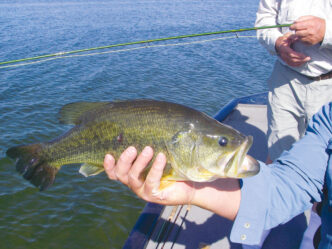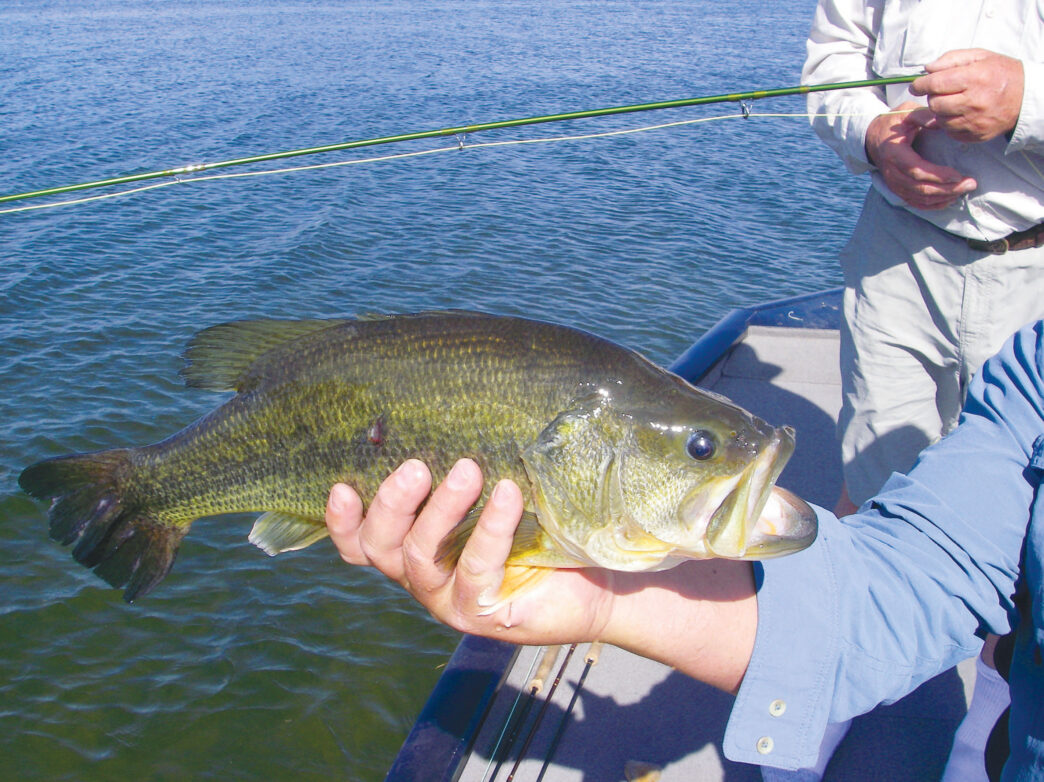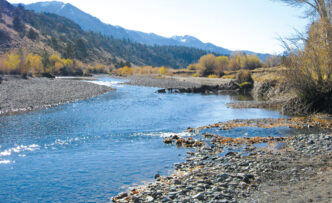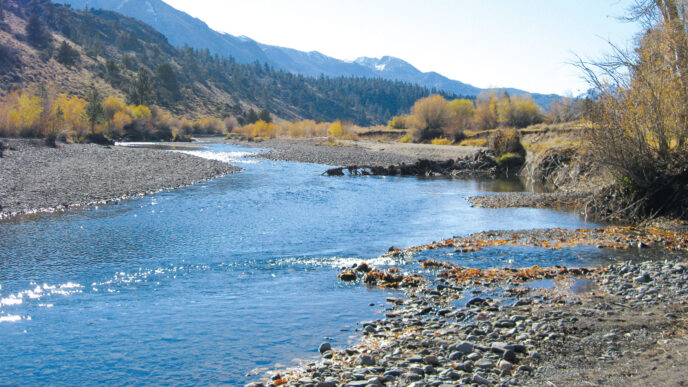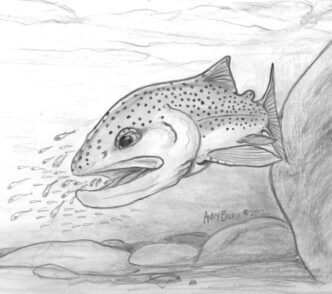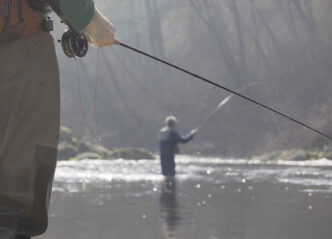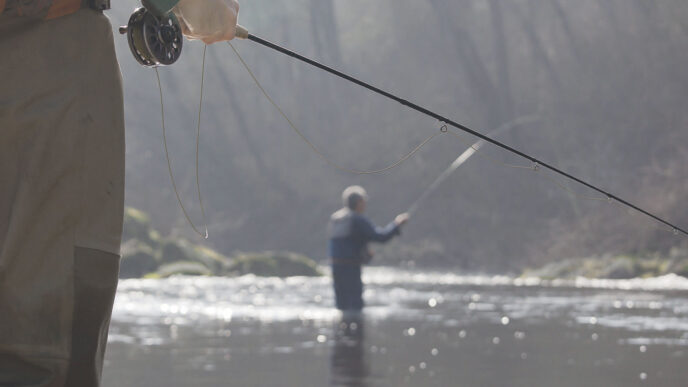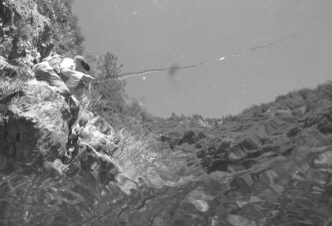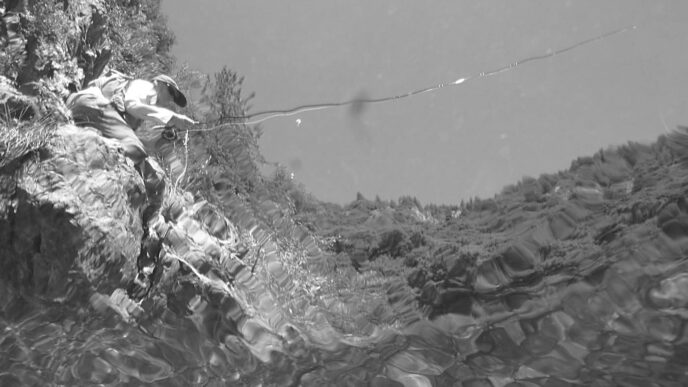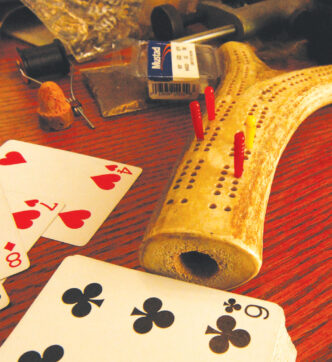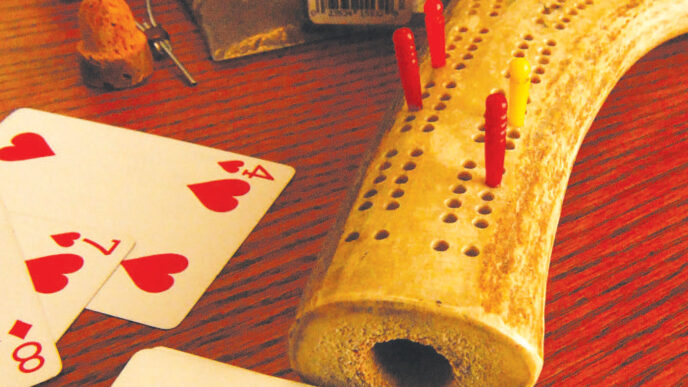I recently watched an angler who was struggling to cast a bass bug toward the edge of an island in the middle of my neighbor’s bass pond. The task that confronts any fly-rod angler targeting largemouth or smallmouth bass is to get a fly rod to cast a big, air-resistant fly that has a cork, foam, or hair body adorned with hackle feathers, tinsel, synthetic hair, and often rubber legs. Their weight and aerodynamic drag make them difficult to cast. The sight of this angler’s efforts made me cringe and reminded me of my own early attempts at bass angling with a fly rod and the gradual evolution of gear and techniques that have made this aspect of fly fishing such a joy and one of my main pursuits.
I was drawn to fly fishing for bass and panfish because there were no trout waters in my neighborhood, and I was born in the South, where the mentality of fly fishing for bass is more common. The trout streams of the Sierra were three hours from my home, but I did have nearby access, legal or otherwise, to ranch ponds, golf course lakes, and several East Bay Municipal Utility District impoundments that held bass and crappies. My first fly rod, which was probably a 6-weight or 7-weight in the modern designation, carried a level, enameled fly line that cracked and hinged within its first week of use. Casting a trout fly any distance was a challenge, but when you tied on a bass bug, things really went downhill fast.
The cliché that necessity is the mother of invention helped anglers of my generation learn from failure before the advent of the Internet, instructional videos, and fly-fishing-club clinics. It turned out that my early fiberglass noodle rod cast better when I started using smaller, less air-resistant bass flies (which I was forced to make) and a tapered leader of my own design. The level fly line carried that bug better as I began to understand what it takes to cast bass bugs well, too. Gradually, I started to figure the thing out. Experience taught me that fine-tuning your gear will raise your success levels considerably, and with practice, the casting part of the game will become second nature. Here are some things I’ve learned that can make fly fishing for bass a pleasure, rather than a frustrating struggle.
Rods for Bass
Many anglers start bass fishing with trout rods. Overlining a trout rod with a weight-forward floating line or, better yet, an aggressive weight-forward bass taper that is one or even two line weights higher than the manufacturer’s designation for that rod will allow the rod to carry the weight and air resistance of your bass bug at short and medium distances. Most modern graphite rods will handle this without breaking. They might, in fact, actually cast better, because a rod with the extra line mass will load at those less-than-long ranges and do what it is supposed to do, which is often not the case when using a fly line weight matched to the rod. A steelhead rod overlined by one or two line weights will cast the largest flies. And a heavier rod, if you have one, obviously is a better choice. I’ve broken several 5-weight rods on bass and learned my lesson. It was not the fish that broke the rods, either. With lighter rods and heavy bass flies, there’s a tendency to cast tailing loops, resulting in collisions between rod shaft and weighted flies, such as Beadhead Woolly Buggers. Then the weight of the bass under your float tube or the strain from horsing a fish away from structure will cause the rod to fail at the site of impact, even if the damage occurred weeks or even years before. Don’t feel bad. That piercing “crack” is a rite of passage in your angling progress.
When you’re getting serious about this aspect of our sport, you may want to obtain a specialty rod that is designed for casting bass-line tapers and for fighting heavy fish close in. These rods will cast a bass fly well at any range. Often you have to pull fish out of cover without allowing a surge back toward the fish’s haven . . . otherwise known as “jacking the fish’s jaw.” A small bass will thrash and allow itself to be slid toward you, but a large one will test the integrity of your equipment. Because not every fly rod will be suitable for this sort of work, I’ll discuss design characteristics that you should look for when choosing a rod for bass angling.
Sage came out with the first specialty bass fly rods a few years ago. The fourpiece rods measure 7 feet, 11 inches long, which allows them to conform to the maximum allowed rod length in sanctioned bass tournaments. With a conforming rod, you can fly fish any tournament, including the Delta Bass-n-Fly Challenge. Fly-fishing club tournaments aren’t so picky, and of course, if you fish to please yourself, you can use any length of rod you want.
It is said that this length restriction came about because of legendary professional bass tournament angler Dee Thomas. Dee specialized in fishing the California Delta and Clear Lake with very long rods, using his “tule-dipping” technique, in which the angler stands at the bow of a bass boat and “swings” or “pitches” a heavy lead jig adorned with hair or plastic into pockets in the tules. Twentypound-test leaders are considered light for this technique, and the rods back then could be over 12 feet long. It is a very effective method and forever changed professional bass angling.
Dee was tearing up the Western circuits in the mid-1970s. His method offended the Eastern good ol’ boys, and they outlawed anything over 7 feet 11 inches to prohibit tule dipping in sanctioned tournaments. In response, Fenwick Rods (early HMG graphite fly rods) then came up with a good dippin’ stick that was under 8 feet. Dee went back East with one and won the 1975 Bassmaster Invitational at Bull Shoals Reservoir.
I had the good fortune and honor to meet and dine with Dee back then. I remember him telling me that I could always find fish in close that I could reach with my fly rod if I knew my water and looked hard enough.
Sage now has several Bass II graphite models. The Largemouth II comes with a 330-grain bass-taper line and the Smallmouth with a 290-grain bass taper. We can equate these to 8-weight and 10-weight rods, respectively. Other manufacturers have followed suit. Temple Fork, for example, has a Mini Mag series of 8-foot rods designed to pull fish out of heavy cover. Some of these rods are being used by saltwater anglers on fish as large as tarpon because of their ability to cast bulky flies and because of their lifting power. They also travel well because of their short, four-piece lengths and are about half the price of top-line saltwater rods. I prefer to use these rods out of a boat where I am casting from a platform of some sort, but they are all-around functional pieces of equipment. My favorite bass-bugging rods are saltwater fly rods in 9-foot lengths. These rods will cast aggressive bass-taper lines effortlessly and lay out a straight line and leader. Again, overline them by at least one line weight. They have oversized guides, which reduce friction, and they have the heavier butt strength that is necessary in bass fishing, but they also maintain the delicate feeling of “touch” that is so important. I always carry my 6-weight saltwater rod on domestic and exotic overseas trips because it is so versatile for all species, including large trout.
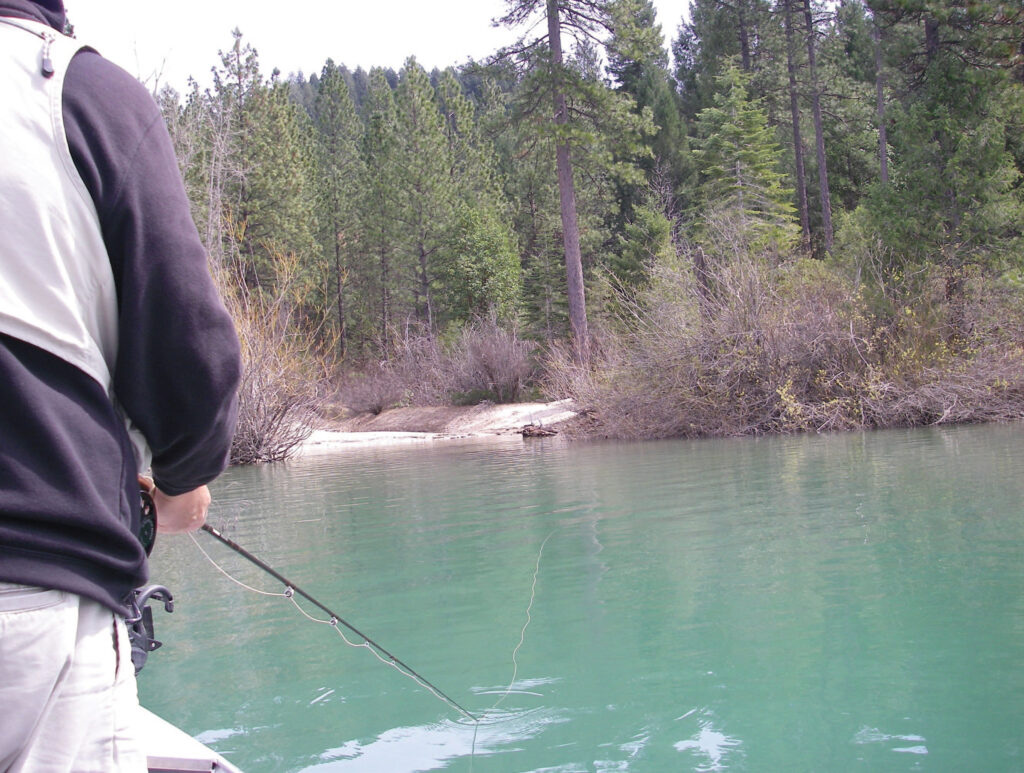
I often fish from a float tube, so 9-foot rods are an advantage when casting because their length helps keep line from slapping the water. For this kind of angling I prefer lower-modulus rods that allow me to cast bugs easily at the closer-in distances that float tubes allow (an example is the Sage RPXLi). Because such rods are not the sort of fast stick that is popular today, they can often be found at fly shops in the used-rod section, complete with their original guarantees, and there is always eBay, as well. I can’t build a top-quality fly rod, much less also receive a factory guarantee with a $50 repair fee, for anywhere near what such deals offer.
When evaluating a rod for bass angling, try to cast it with several lines to see how much overlining it needs, then tie on a real bass fly that has feathers and rubber legs and see how it works for your casting style. In bass bugging, you need to open up your casting loops a bit, but top-quality rods also allow you to cast tight loops and shoot for distance when needed. The specialty bass rods and adapted saltwater sticks not only cast top-water flies on floating lines, but also function exceptionally well when fishing intermediate or high-density sinking lines with heavier subsurface flies such as Clousers.
Reels for Bass
Reels are not all that important in bass fishing. Bass rarely run in a straight line for long distances, although there is always the exception. I remember my Mexican guide Pedro screaming “seis kilos, seis kilos” at El Salto as a huge bass ran toward a stickup 30 yards distant like she had a GPS bearing on it. It wouldn’t have mattered what kind of a reel I had. Pioneering California Clear Lake bass angler Lucky Lloyd Iseman used an old Martin automatic fly reel. He sculled a small wooden skiff with one hand and cast and controlled the line with that reel and the other.
Large arbor reels help gather line, but I rarely get a fish on the reel unless it is really big. Most I play by stripping in line. This avoids the transition from stripping to fighting the fish on the reel, a point when many fish are lost. Often you just don’t have the time. You are stripping like mad to keep slack out of your line as your fish dives under your float tube.
Leaders for Bass
Leaders influence casting proficiency in a big way. I recently talked with a top California fly-rod bass angler who works at a fly shop that sells lots of bass gear. We both agreed that stealth in bass fishing is just as important as in trout fishing, and that includes the kind of leader you use. I favor supple, 9-foot 0X 15-pound-test leaders, which can be shortened a foot or so while still keeping an adequate distance between the fly and that bass-bug-taper fly line. A leader this length provides a little stretch that helps tremendously in protecting knots from the shock that leads to catastrophic failure. A long, progressive-taper bass leader will turn over your fly, lay it out the full length of your leader, and land it softly. You can also cast side arm and throw your bug under docks and overhanging tree limbs where fish lie. More strikes will come from this approach than from a close-in attack with a 4-foot piece of level mono.
I have tried and discarded the heavy furled leaders that require a tippet tied onto a small ring. The heavy butt is as thick as my bass-taper line. My goal is an effortless cast that lays out my leader completely and drops the fly down gently, although I also sometimes modify my cast to slam the fly down hard or open up my loop and let the bug flutter down ever so softly. Occasionally, a bass will jump clear out of the water to take your fly on the way down.
My second choice in leaders is made from a conventional heavy-test leader that has been excessively shortened due to repeated use. I recycle these expensive things, adding 02X fluorocarbon (which, with the brand I use, is a high-strength 20-pound test with only a .013-inch diameter) to about 5 feet of the old leader. Fluorocarbon provides abrasion resistance and, at this diameter, is still fairly supple for animating your fly. I always use a loop knot to attach my flies to the tippet, which helps in that regard, as well. You can drop down to 15-pound test or less, but I fish lots of heavy cover and want a strong tippet when I hook a trophy fish that decides to head home. You may get only one chance a year at a fish of 8 or 10 pounds.
Bass may not be as fast as trout, but their strong, sudden, and prolonged surges can and do pop leaders and knots. You should keep a tighter line than in trout fishing when fish leap. Bass have a well-deserved reputation for throwing lures with violent, repeated head shakes. Ever wonder how a bass can possibly throw a triple treble-hooked crankbait? Both they and your fly-rod creations have much more mass than trout flies and are therefore easier to throw.
I also find it important to tune my leader for the individual characteristics of my fly so I can cast effortlessly. Six or 12 inches removed from or added to a leader can make a huge difference. I don’t change flies a lot, so tuning the length of the leader in this way isn’t a hassle.
Casting for Bass
Successful bass angling with a fly rod brings all casting skills to bear. Paramount is the ability to cast at medium distances and beyond with accuracy and stealth. Rig a rod, fine-tune a leader and fly, and practice. Six weeks of 10 minutes a day, three times a week in the backyard or nearby park will move your casting skills quantum leaps forward.
Line cleaning on a daily basis will help your casting ability. Warmwater fisheries tend to have more nutrient and particulate matter in the water than trout streams. Fly lines, particularly larger-diameter ones, such as bass-bug tapers, attract this material, which adds to line friction, may cause the tip of your fly line to sink, and will accelerate deterioration of the line finish. I clean my lines daily. It makes a difference.
I try to cast from a considerable distance toward structure that I know or think holds fish, because over and over, I have witnessed fish being spooked by anglers who get too close, especially in clear water. Jay Fair once told me of a small lake near Susanville where he and his son, Glenn, noticed that after a few casts, all the bass would move to the far side of the lake.
Several years ago, I left the rods in my truck and carried cameras to photograph bass in spawning mode. I marked at least half a dozen fish. As luck would have it, there was a local tournament on that day, and I watched small and large boats consistently drive fish off their lies because the anglers got too close. Bass didn’t develop sensitive lateral lines for nothing. What terrified them the most were big, flashy, metallic spinnerbaits. It’s hard to fish successfully behind a fleet of high-horsepower bass boats, so I avoid fished-over areas and always check for and avoid conventional-tackle bass tournaments. Bass angling with a fly rod is a specialized skill that will open new waters and experiences to you. To avoid frustration, though, it helps to use the right combination of line, leader, and fly and then to tune your outfit by adjusting your leader to match your fly selection. Practice you casting, too. Then go fishing. If you want to take it a step further, there are specialty bass rods and saltwater sticks that will allow you to become a master.



